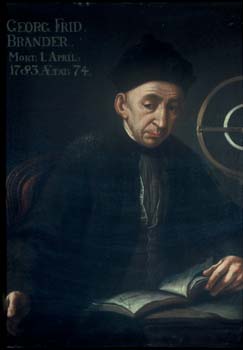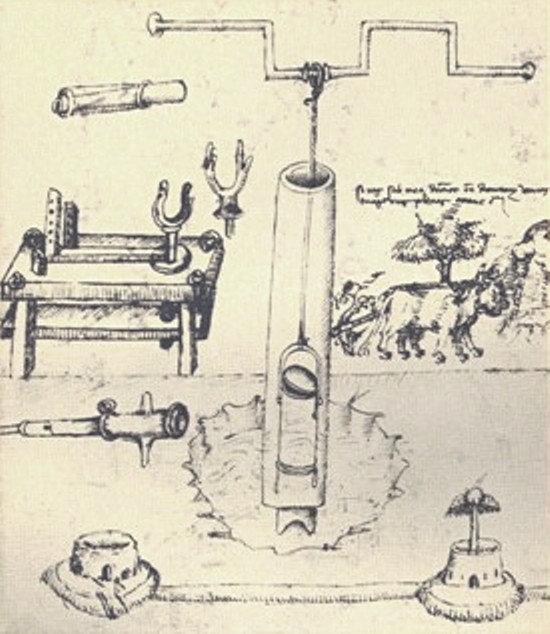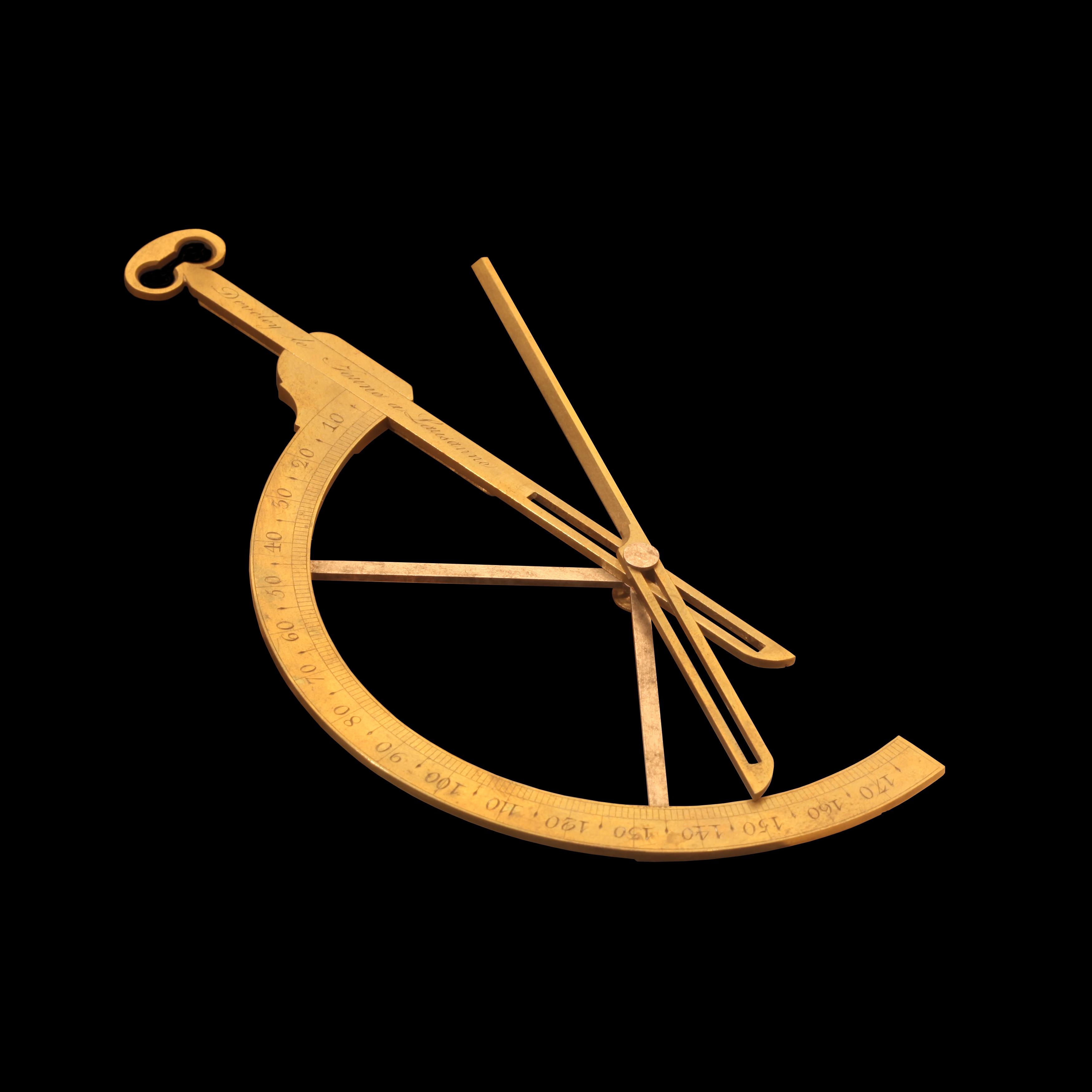|
Georg Friedrich Brander
Georg Friedrich Brander (* 28. November 1713 in Regensburg; † 1. April 1783 in Augsburg) was an important maker of scientific instruments. Early years Brander was born 1713 to Georg Brandner, an apothecary with roots in Nuremberg, and Sibylla Katharina Brandner (widowed Pfaffreuter, 1678–1756) from a Regensburg goldsmith family. He studied in Altdorf bei Nürnberg from 1731 to 1734 mathematics and physics under the supervision of Johann Gabriel Doppelmayr. Professional work In 1734 he moved to Augsburg (Germany), where he founded a workshop for fine mechanics. He was supported by local financier Josef von Halder with capital and in establishing a business network. Brander was the first one in Germany to build a mirror telescope in 1737. Since 1754 the workshop has produced also microscopes, and the high-resolution micrometer glass rulers were its speciality. A telescope, coupled in 1776 with a map of the starry sky, is named "starfinder". In 1778 he invented the coin ... [...More Info...] [...Related Items...] OR: [Wikipedia] [Google] [Baidu] |
Surveying
Surveying or land surveying is the technique, profession, art, and science of determining the land, terrestrial Plane (mathematics), two-dimensional or Three-dimensional space#In Euclidean geometry, three-dimensional positions of Point (geometry), points and the Euclidean distance, distances and angles between them. These points are usually on the surface of the Earth, and they are often used to establish maps and boundaries for ownership, locations, such as the designated positions of structural components for construction or the surface location of subsurface features, or other purposes required by government or civil law, such as property sales. A professional in land surveying is called a land surveyor. Surveyors work with elements of geodesy, geometry, trigonometry, regression analysis, physics, engineering, metrology, programming languages, and the law. They use equipment, such as total stations, robotic total stations, theodolites, Satellite navigation, GNSS receivers, ... [...More Info...] [...Related Items...] OR: [Wikipedia] [Google] [Baidu] |
1713 Births
Events January–March * January 17 – Tuscarora War: Colonel James Moore leads the Carolina militia out of Albemarle County, North Carolina, in a second offensive against the Tuscarora. Heavy snows force the troops to take refuge in Fort Reading, on the Pamlico River. * February 1 – Skirmish at Bender, Moldova: Charles XII of Sweden is defeated by the Ottoman Empire. * February 4 – Tuscarora War: The Carolina militia under Colonel James Moore leaves Fort Reading, to continue the campaign against the Tuscarora. * February 25 – Frederick William I of Prussia begins his reign. * March 1 – Tuscarora War: Colonel James Moore's Carolina militia lays siege to the Tuscaroran stronghold of Fort Neoheroka, located a few miles up Contentnea Creek from Fort Hancock. * March 20 – Tuscarora War: Colonel James Moore's Carolina militia launches a major offensive against Fort Neoheroka. * March 23 – Tuscarora War: Fort Neoheroka falls to the ... [...More Info...] [...Related Items...] OR: [Wikipedia] [Google] [Baidu] |
Mechanics (people)
Mechanics () is the area of physics concerned with the relationships between force, matter, and motion among physical objects. Forces applied to objects may result in displacements, which are changes of an object's position relative to its environment. Theoretical expositions of this branch of physics has its origins in Ancient Greece, for instance, in the writings of Aristotle and Archimedes (see History of classical mechanics and Timeline of classical mechanics). During the early modern period, scientists such as Galileo Galilei, Johannes Kepler, Christiaan Huygens, and Isaac Newton laid the foundation for what is now known as classical mechanics. As a branch of classical physics, mechanics deals with bodies that are either at rest or are moving with velocities significantly less than the speed of light. It can also be defined as the physical science that deals with the motion of and forces on bodies not in the quantum realm. History Antiquity The ancient Greek phi ... [...More Info...] [...Related Items...] OR: [Wikipedia] [Google] [Baidu] |
18th-century German Inventors
The 18th century lasted from 1 January 1701 (represented by the Roman numerals MDCCI) to 31 December 1800 (MDCCC). During the 18th century, elements of Enlightenment thinking culminated in the Atlantic Revolutions. Revolutions began to challenge the legitimacy of monarchical and aristocratic power structures. The Industrial Revolution began mid-century, leading to radical changes in human society and the environment. The European colonization of the Americas and other parts of the world intensified and associated mass migrations of people grew in size as part of the Age of Sail. During the century, slave trading expanded across the shores of the Atlantic Ocean, while declining in Russia and China. Western historians have occasionally defined the 18th century otherwise for the purposes of their work. For example, the "short" 18th century may be defined as 1715–1789, denoting the period of time between the death of Louis XIV of France and the start of the French Revolut ... [...More Info...] [...Related Items...] OR: [Wikipedia] [Google] [Baidu] |
Marriage Symbol
Marriage, also called matrimony or wedlock, is a culturally and often legally recognised union between people called spouses. It establishes rights and obligations between them, as well as between them and their children (if any), and between them and their Affinity (law), in-laws. It is nearly a cultural universal, but the definition of marriage varies between cultures and religions, and over time. Typically, it is an institution in which interpersonal relationships, usually sexual, are acknowledged or sanctioned. In some cultures, marriage is recommended or considered to be Premarital sex, compulsory before pursuing sexual activity. A marriage ceremony is called a wedding, while a private marriage is sometimes called an elopement. Around the world, there has been a general trend towards ensuring Women's rights, equal rights for women and ending discrimination and harassment against couples who are Interethnic marriage, interethnic, Interracial marriage, interracial, In ... [...More Info...] [...Related Items...] OR: [Wikipedia] [Google] [Baidu] |
Deutsches Museum
The Deutsches Museum (''German Museum'', officially (English: ''German Museum of Masterpieces of Science and Technology'')) in Munich, Germany, is the world's largest museum of science museum, science and technology museum, technology, with about 125,000 exhibited objects from 50 fields of science and technology. It receives about 1.5 million visitors per year. The museum was founded on 28 June 1903, at a meeting of the Verein Deutscher Ingenieure, Association of German Engineers (VDI) as an initiative of Oskar von Miller. It is the largest museum in Munich. For a period of time the museum was also used to host pop and rock concerts including The Who, Jimi Hendrix and Elton John. Museumsinsel The main site of the Deutsches Museum is a small island in the Isar river, which had been used for rafting wood since the Middle Ages. The island did not have any buildings before 1772 because it was regularly flooded prior to the building of the Sylvensteinspeicher. In 1772 the ... [...More Info...] [...Related Items...] OR: [Wikipedia] [Google] [Baidu] |
Mechanics
Mechanics () is the area of physics concerned with the relationships between force, matter, and motion among Physical object, physical objects. Forces applied to objects may result in Displacement (vector), displacements, which are changes of an object's position relative to its environment. Theoretical expositions of this branch of physics has its origins in Ancient Greece, for instance, in the writings of Aristotle and Archimedes (see History of classical mechanics and Timeline of classical mechanics). During the early modern period, scientists such as Galileo Galilei, Johannes Kepler, Christiaan Huygens, and Isaac Newton laid the foundation for what is now known as classical mechanics. As a branch of classical physics, mechanics deals with bodies that are either at rest or are moving with velocities significantly less than the speed of light. It can also be defined as the physical science that deals with the motion of and forces on bodies not in the quantum realm. History ... [...More Info...] [...Related Items...] OR: [Wikipedia] [Google] [Baidu] |
Theodolite
A theodolite () is a precision optical instrument for measuring angles between designated visible points in the horizontal and vertical planes. The traditional use has been for land surveying, but it is also used extensively for building and infrastructure construction, and some specialized applications such as meteorology and rocket launching. It consists of a moveable telescope mounted so it can rotate around horizontal and vertical axes and provide angular readouts. These indicate the orientation of the telescope, and are used to relate the first point sighted through the telescope to subsequent sightings of other points from the same theodolite position. These angles can be measured with accuracies down to microradians or seconds of arc. From these readings a plan can be drawn, or objects can be positioned in accordance with an existing plan. The modern theodolite has evolved into what is known as a total station where angles and distances are measured electronicall ... [...More Info...] [...Related Items...] OR: [Wikipedia] [Google] [Baidu] |
Leveling Instrument
A level is an optical instrument used to establish or verify points in the same horizontal plane in a process known as ''levelling''. It is used in conjunction with a levelling staff to establish the relative height or levels (the vertical separation) of objects or marks. It is widely used in surveying and construction to measure height differences and to transfer, measure, and set heights of known objects or marks. It is also known as a surveyor's level, builder's level, dumpy level or the historic "Y" level. It operates on the principle of establishing a visual level relationship between two or more points, for which an inbuilt optical telescope and a highly accurate bubble level are used to achieve the necessary accuracy. Traditionally the instrument was completely adjusted manually to ensure a level line of sight, but modern automatic versions self-compensate for slight errors in the coarse levelling of the instrument, and are thereby quicker to use. The optical level shou ... [...More Info...] [...Related Items...] OR: [Wikipedia] [Google] [Baidu] |
Goniometer
A goniometer is an instrument that either measures an angle or allows an object to be rotated to a precise angular position. The term goniometry derives from two Greek words, γωνία (''gōnía'') 'angle' and μέτρον (''métron'') ' measure'. The protractor is a commonly used type in the fields of mechanics, engineering, and geometry. The first known description of a goniometer, based on the astrolabe, was by Gemma Frisius in 1538. Protractor A protractor is a measuring instrument, typically made of transparent plastic, for measuring angles. Some protractors are simple half-discs or full circles. More advanced protractors, such as the bevel protractor, have one or two swinging arms, which can be used to help measure the angle. Most protractors measure angles in degrees (°). Radian-scale protractors measure angles in radians. Most protractors are divided into 180 equal parts. Some precision protractors further divide degrees into arcminutes. A protractor divided ... [...More Info...] [...Related Items...] OR: [Wikipedia] [Google] [Baidu] |
Sextant
A sextant is a doubly reflecting navigation instrument that measures the angular distance between two visible objects. The primary use of a sextant is to measure the angle between an astronomical object and the horizon for the purposes of celestial navigation. The estimation of this angle, the altitude, is known as ''sighting'' or ''shooting'' the object, or ''taking a sight''. The angle, and the time when it was measured, can be used to calculate a position line on a nautical or aeronautical chart—for example, sighting the Sun at noon or Polaris at night (in the Northern Hemisphere) to estimate latitude (with sight reduction). Sighting the height of a landmark can give a measure of ''distance off'' and, held horizontally, a sextant can measure angles between objects for a position on a chart. A sextant can also be used to measure the lunar distance between the moon and another celestial object (such as a star or planet) in order to determine Greenwich Mean Time and hence ... [...More Info...] [...Related Items...] OR: [Wikipedia] [Google] [Baidu] |









